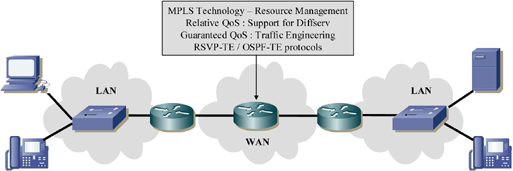Chapter 7
MPLS Technology – Resource Management
7.1. Introduction
Resource management refers to the implementation of different protocols to offer relative quality of service (QoS) or guaranteed QoS in a Multiprotocol Label Switching (MPLS) network (Figure 7.1).
Relative QoS is associated with the DiffServ model, for which the protocol is carried by the MPLS header. The Edge label switching router (LSR) defines a correspondence between MPLS and DiffServ by performing mapping:
– either between the DiffServ Code Point (DSCP) field of the Internet Protocol (IP) header and the EXP field of the MPLS header,
– or between the DSCP field of the IP header and an LSP (Label Switching Path) virtual circuit.
Traffic engineering (TE) is the term used to refer to the implementation of resource reservation in an MPLS environment. It is set up to constitute tunnels for which some bandwidth is reserved. A tunnel is defined by the identifiers of its endpoints (IP addresses of the Edge LSRs). An LSP virtual circuit embodies the realization of this tunnel.
TE introduces an extension to open shortest path first (OSPF) routing protocols, in order to support constraints such as the availability of the resource at the link level, for determining the path between the ingress and egress LSRs.
Figure 7.1. MPLS technology – resource management

Guaranteed QoS is associated with TE, for which the RSVP-TE protocol ...
Get IP, Ethernet and MPLS Networks: Resource and Fault Management now with the O’Reilly learning platform.
O’Reilly members experience books, live events, courses curated by job role, and more from O’Reilly and nearly 200 top publishers.

